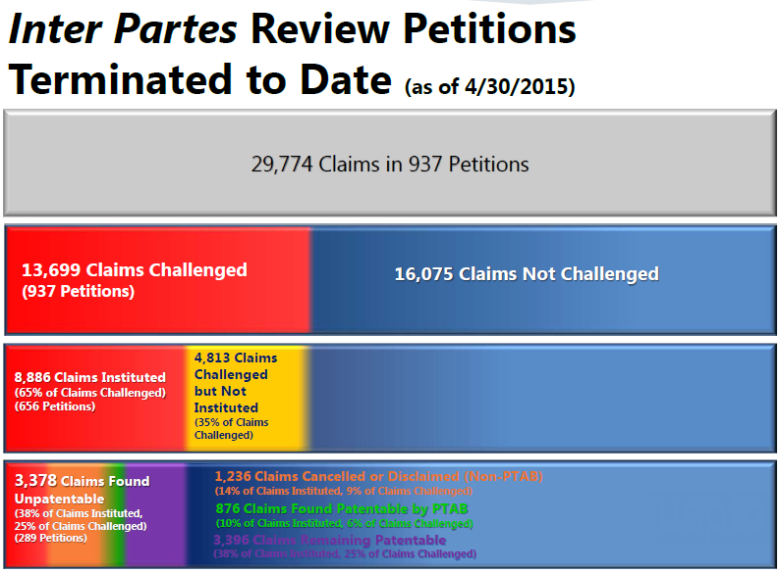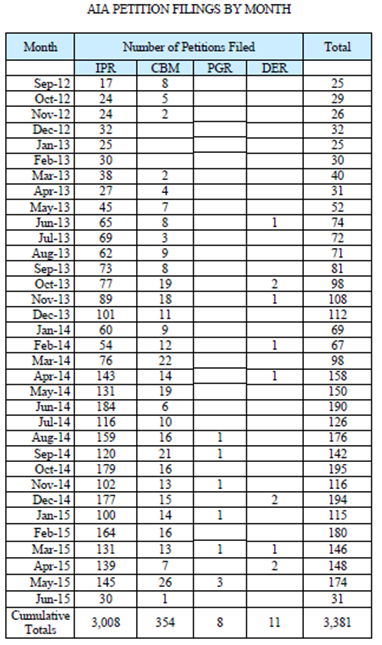June 4, 2015 PTAB Trial Statistics
As of June 4, 2015, the Patent Trial and Appeal Board (“PTAB”) has updated the statistics of the number of inter partes reviews (“IPR”), post-grant reviews of covered business method patents (“CBM”), regular post-grant reviews (“PGR”) and derivation proceedings (“DER”) that have been filed. These stats are shown below, and can be found at:
https://www.uspto.gov/ip/boards/bpai/stats/aia_trial_statistics.jsp
The graph/chart form of these statistics can be found here:
http://www.uspto.gov/sites/default/files/documents/060415_aia_stat_graph.pdf
The proceeding statistics (filings broken down by quarter of each fiscal year) are found here:
http://www.uspto.gov/sites/default/files/ip/boards/bpai/stats/aia_trial_proceedings.pdf
The progress statistics are found here:
http://www.uspto.gov/sites/default/files/documents/aia_statistics_06-04-2015.pdf
It is worth noting that the first regular PGR (not for CBM) was filed on August 5, 2014. As shown below, there are now 8 PGR petitions that have been filed (2 in FY2014 and 6 9 in FY2015). This should ramp up when more and more patents qualify (must be a first-inventor-to-file patent).
For the first phase of an AIA trial, the PTAB determines whether or not an IPR, PGR or CBM will be granted. The PTAB may not authorize the IPR unless the petition and response shows there is a “reasonable likelihood” that the petitioner would prevail with at least one of the challenged claimed. The granting of a PGR/CBM trial requires an initial threshold requirement of “more likely than not”, and is slightly higher than the IPR threshold standard. However, the latest statistics clearly show that the initial threshold has been met the majority of the time (see the AIA Trials Instituted/Disposals chart below). Note that the new fiscal year (2015) for the USPTO started on October 1, 2014. The number of AIA Petitions, where almost 2,900 IPR petitions have been filed, is as follows:
NUMBER OF AIA PETITIONS
| FY | Total | IPR | CBM |
PGR
|
DER |
| 2012 | 25 | 17 | 8 | ||
| 2013 | 563 | 514 | 48 | 1 | |
| 2014 | 1,494 | 1,310 |
177
|
2
|
5 |
|
2015
|
1,299
|
1,167
|
121
|
6
|
5
|
| Cumulative | 3,381 | 3,008 | 354 |
8
|
11 |
The graphic form of the AIA filings as of 05/14/2015 is shown below (note the decreased filing from Jan – March this year, but a surge since April 2014):
|
Total
|
3,381
|
| IPR | 3,008 |
| CBM | 354 |
| PGR | 8 |
| DER | 11 |
For the last fiscal year, the petitions by technology breakdown are (bio/pharma has increased, partially due to the hedge fund filings attacking pharmaceutical patents):
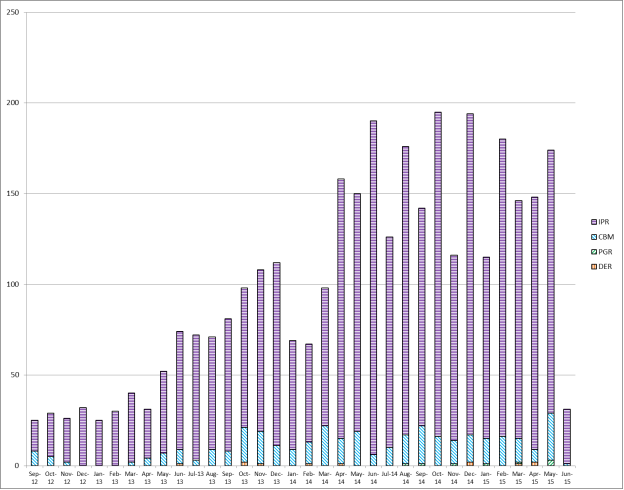
AIA PETITION TECHNOLOGY BREAKDOWN – FY 2015
|
Technology |
Number of Petitions | Percentage |
|
Electrical/Computer- TCs 2100, 2400, 2600, 2800 |
810 | 62.4% |
|
Mechanical- TCs 3600, 3700 |
317 | 24.4% |
|
Chemical- TC 1700 |
62 | 4.8% (slight increase) |
|
Bio/Pharma- TC 1600 |
107 | 8.2% (slight decrease) |
|
Design- TC 2900 |
3 | 0. (same) |
The pie chart for these filings are as follows (almost 2/3 in electrical/computer arts):
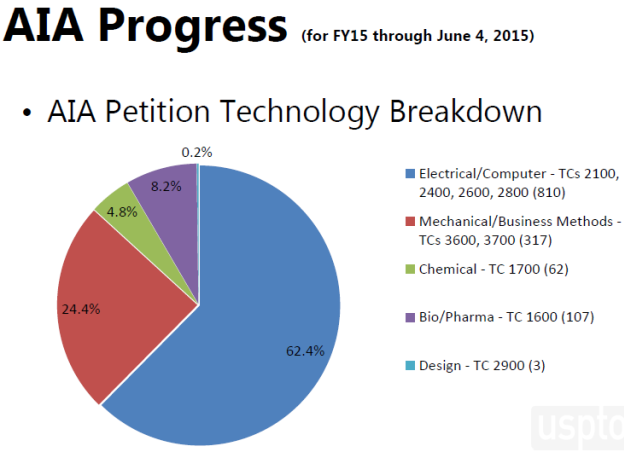
During an IPR, PGR or PGR for CBM, the Patent Owner (“PO”) can optionally file a Preliminary Response.[2] Clearly, according to these statistics, the PO is choosing to file a Preliminary Response most of the time (overall 82.9%). Also, 3 out of 4 were filed in the PGR requests. The number of filed PO Preliminary Responses is in the next chart:
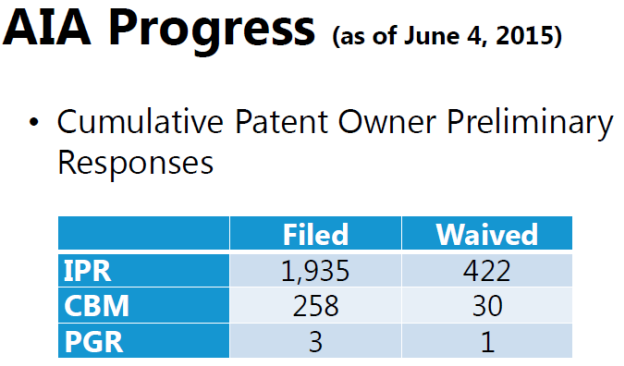
The institution rate includes fiscal year 2015 as shown below. Note that there are already several cases of joinder in 2015.
AIA PETITION DISPOSITIONS:

AIA FINAL DISPOSITIONS:
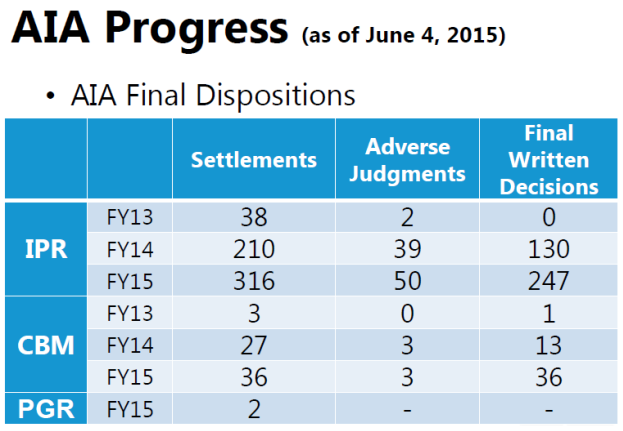
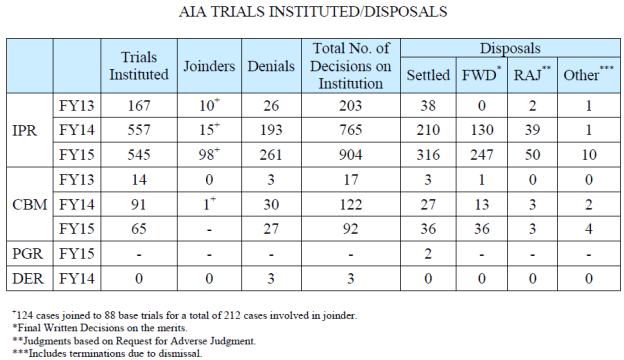
The USPTO also releases the following graph related to how many claims are challenged, instituted, and found unpatentable (cancelled) in IPRs (as of 04/30/2015), where 937 Petitions were surveyed:
For the bottom bar: red is 3,378 claims found unpatentable by the PTAB; orange is 1,236 claims canceled or disclaimed by the patent owner; green is 876 claims found patentable (survived trial); and purple are 3,396 claims found patentable, but likely due to settlement/termination of the trial.
The USPTO provides the following table where the trend in filings can be seen here (not the upward trend since April 2014 and overall steady since then):
More information on the USPTO PTAB can be found here.
- 77 Fed. Reg. 48764 (Aug. 14, 2012).
- Id. at 48756.


